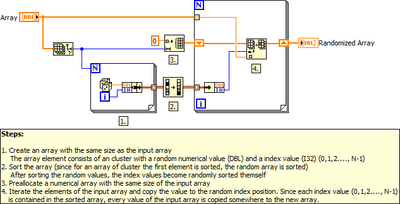Simple Way to Randomize an Array
- Subscribe to RSS Feed
- Mark as New
- Mark as Read
- Bookmark
- Subscribe
- Printer Friendly Page
- Report to a Moderator
Products and Environment
This section reflects the products and operating system used to create the example.To download NI software, including the products shown below, visit ni.com/downloads.
- LabVIEW
Software
Code and Documents
Attachment
Overview
The example demonstrates how to randomize the order of an array.
Description
To randomize the order of an array there are many possibilities. In this case the example generates a random array with the same length and is sorted. Looking at the indices of the array after the sort, you get a pretty random order that can be used to rearrange the input array in a random way.
Requirements
Software
- LabVIEW 2012 Base Development System (or compatible)
Hardware
- No hardware is necessary to use this example VI
Steps to Implement or Execute Code
- (Optional) Change array or use this VI as an subVI
- Run the VI
Additional Information or References
Remark:
A previous example used another algorithm to randomize the order of the input array. Since the calculation takes orders of magnitudes longer to calculate and does not effectively randomize longer arrays (>300 elements), the algorithm has been changed to reduce memory access and the number of random number generation.
Also as already mentioned in the comments:
The 'Riffle' function can be used to achive the same task.
**The code for this example has been edited to meet the new Community Example Style Guidelines. The edited copy is marked with the text 'NIVerified'. Read here for more information about the new Example Guidelines and Community Platform.**
Example code from the Example Code Exchange in the NI Community is licensed with the MIT license.
- Mark as Read
- Mark as New
- Bookmark
- Permalink
- Report to a Moderator
Hey Dr.Horrible,
Good example. If anyone has at least the full version, they can also use the "Riffle" function to get the same functionality. Cheers!
Field Engineer
- Mark as Read
- Mark as New
- Bookmark
- Permalink
- Report to a Moderator
There a several problem:
- If you input array has a million elements, 1000 iterations won't cut it. Thee code does not scale!
- That constant array resizing (delete from array, insert into array) causes a huge memory allocation overhead penalty. Very inefficient.
- There is a statistical flaw. Because you round to the nearest integer, the first and last elements only have half the chance to be touched compared to all others. (Solution: Don't subtract (-1) from the array size, but round to -infinity instead.)
For a better solution, see my comment here for a much easier way.
...and if you have anything above LabVIEW base, use riffle. No code needed.


